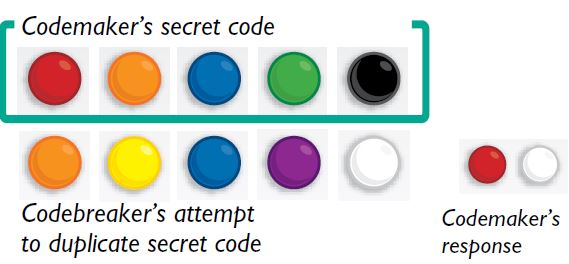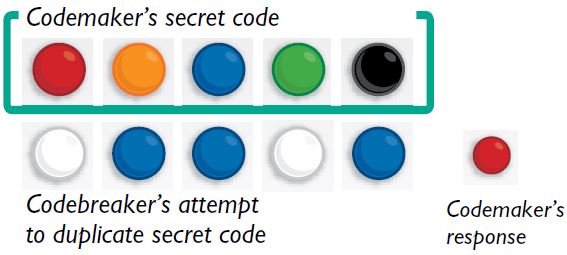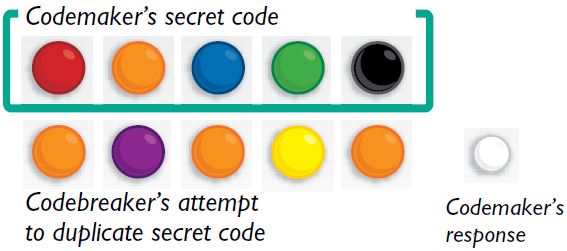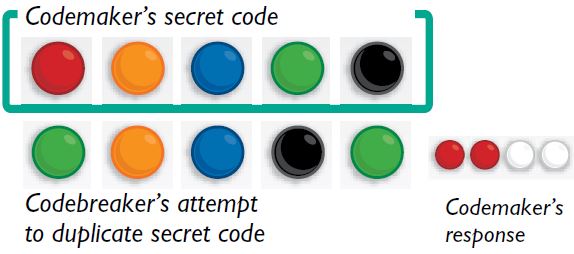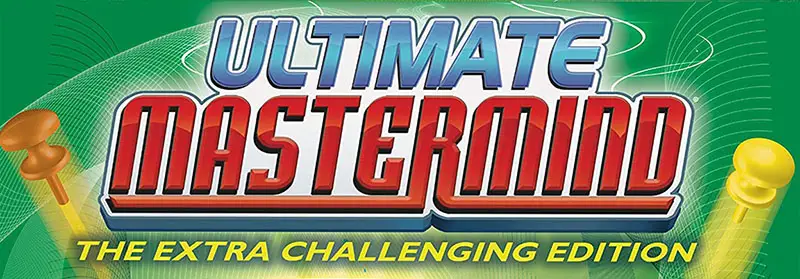
Components
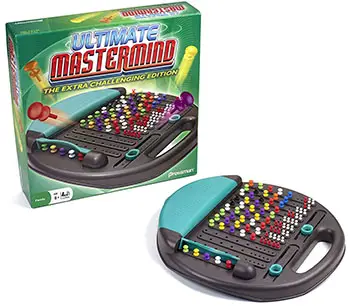
Ultimate MASTERMIND game console with built in storage area for pegs, hinged shield to conceal secret code section, scoring area
Code pegs-approximately 144 large round headed pegs (about 18 of each 8 colors).
Key Pegs-approximately 40 small pegs (about 20 each of red and white).
Object of the Game
The Codebreaker tries to guess the color sequence of a row of 5 pegs in as few turns as possible. After each turn, the Codemaker will give feedback that will help the Codebreaker figure it out!
Setup
Separate the Code pegs from the Key pegs. Decide which player will be the Codemaker and which will be the Codebreaker (players will switch positions after the first round). Position the board between the players so that the 5 shielded holes for the secret code face the Codemaker.
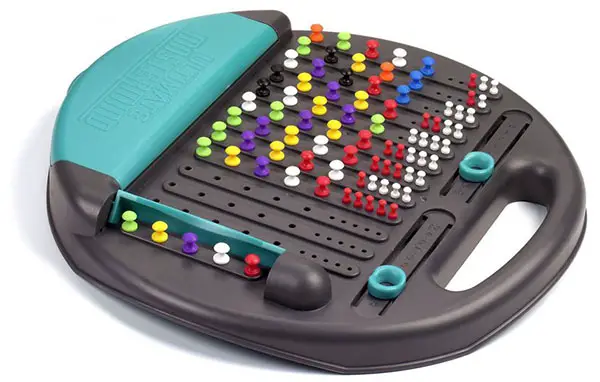
Ultimate Game One
(32,768 Variations)
The Codemaker secretly places any combination of five Code pegs into the five holes concealed by the shield. The Codemaker can use any combination of the eight colors, including using two or more Code pegs of the same color.
The Codebreaker places five Code pegs in the first row of holes closest to him. As with the Codemaker, he can use two or more Code pegs of the same color. The Codebreaker is trying to discover the exact colors and positions of the Codemaker's pegs.
The Codemaker responds by placing 0 to 5 Key pegs in the Key peg holes, in any order, on the first row using these rules:
- Place a red Key peg for each Code peg that is the right color and in the right position.
- Place a white Key peg for each Code peg that's the right color but in the wrong position.
Remember that the Codemaker is placing the small Key pegs in any order so that the Codebreaker does NOT know what Code pegs they relate to! It is part of the challenge of MASTERMIND to figure out which Code pegs correspond to particular Key pegs.
Place no Key pegs for any Code peg whose color does not appear at all in the secret code. SEE "FIRST TURN" EXAMPLE.
When two pegs of the same color appear in the secret code and/or in the Codebreaker's row just remember that one Key peg corresponds to one Code peg and a red Key peg takes precedence over a white one. SEE "SECOND TURN" EXAMPLE.
The Codebreaker places another set of Code pegs in the second row and the Codemaker places the Key pegs in the second row following the above rules. Both the Code pegs and the Key pegs played in each row are left in position until the code is broken.
The Codebreaker keeps placing rows of Code pegs and getting feedback from the Codemaker until he guesses the code exactly. At this point the Codemaker places five red Key pegs and reveals the secret code. The players then score (see below) and switch roles for the next game.
End of the Game
There are two ways to keep score.
Games Scoring:
The Codebreaker counts how many rows it took him to break the code (ie: eight). Players switch places and play as above. When the new Codebreaker breaks the code
he counts how many rows it took him to solve it. Whichever player broke their code in fewer moves slides their score keeper up to 1. Players continue until one player wins ten games. (or as many games as agreed upon).
Point Scoring:
Players decide how many games they want to play. After each code is broken, the Codemaker gets one point for each row played by the Codebreaker and writes that number under his name on a piece of paper.
The players then switch roles and the new Codemaker will get one point for each row played by the Codebreaker and writes that number down in his column. After the agreed upon number of games have been played, the player with the highest score wins.
Note: During a game, if all 12 rows are used and the code has not been broken, the Codemaker is awarded 13 points (12 points + 1 bonus point).
If the Codebreaker can show that the Codemaker has given wrong information, the game is replayed and 3 extra points are given to the Codebreaker.
Ultimate Game Two
(59,049 Variations).
Play is the same as Ultimate Game 1, but the Codemaker may leave one or more Code peg holes vacant, making the number of Code pegs used in the game equivalent to nine. Think of a vacant hole as being another Code peg color.
Time Limits
If the Codebreaker continually takes too long at his turn, a time limit of 3 or 4 minutes may be set.
Examples
First Turn
The response at the right indicates one right color in the right place BLUE, one right color in the wrong place ORANGE, and three wrong colors. The Key pegs do not indicate which colors are which.
Second Turn
The response shows one right color in the right place (the BLUE in the middle of the code). Note that the Codemaker plays only one Key peg even though three blue Code pegs were played, because he has only one blue Code peg in the secret code. Note also that he plays a red Key peg in preference to a white Key peg.
Third Turn
Just 1 white Key peg is played for one ORANGE.
Fourth Turn
The two red key pegs are for the ORANGE and the BLUE Code pegs. The two white key pegs are for one GREEN Code peg and the one BLACK code peg.
Continue Reading
